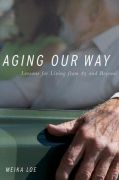
Elders 85 years and older are the fastest growing segment of the population in the U.S. and in many other countries. Aging Our Way examines how the very old navigate the challenges of loneliness, disability, and loss, while staying healthy, connected, and comfortable. In 1998, Hallmark unveiled their new "One-Hundredth-Birthday" cards, and by 2007 annual sales were at 85,000. America is rapidly graying: between now and 2030, the number of people in the U.S. overthe age of 80 is expected to almost triple. But how long people live raises the question of how well they live. Aging Our Way follows the everyday lives of 30 elders (ages 85-102) living at home and mostly alone to understand how they create and maintain meaningful lives for themselves. Drawing on the latest interdisciplinary scholarship on aging and three years of interviews with the elders, Meika Loe explores how elders navigate the practical challenges of living as independently as possible while staying healthy, connected, and comfortable. While most books on the subject treat old age as asocial problem and elders as simply diminished versions of their former selves, Aging Our Way views them as they really are: lively, complicated, engaging people finding creative ways to make their aging as meaningful and manageable as possible. In their own voices, elders describe how they manage everythingfrom grocery shopping, doctor appointments, and disability, to creating networks of friends and maintaining their autonomy. In many ways, these elders can serve as role models. The lessons they have learned about living in moderation, taking time for themselves, asking for help, keeping a sense of humor, caring for others, and preparing for death provide an invaluable source of wisdom for anyone hoping to live a long and fulfilling life. Through their stories, Loe helps us to think about aging,well-being, and the value of human relationships in new ways. Written with remarkable warmth and depth of understanding, Aging Our Way offers a vivid look at a group of people who too often remain invisible--those who have lived the longest--and all they have to teach us. INDICE: Prologue: 30-60-90: A Short Meditation on Age and Perspective Introduction: Living at Home and Making it Work Lesson 1: Continue to Do What You Did Lesson 2: (Re) Design Your Living Space Lesson 3: Live in Moderation Lesson 4: Take Time for Self Lesson 5: Ask for Help; Mobilize Resources Lesson 6: Connect with Peers Lesson 7: Resort to Tomfoolery Lesson 8: Care for Others Lesson 9: Reach out to Family Lesson 10: Get Intergenerational; Redefine Family Lesson 11: Insist on Hugs Lesson 12: Be Adaptable Lesson 13: Accept and Preparefor Death Conclusion: New Perspectives on the Oldest Old Postscript: On DoingNinety (by Ann, research participant) Epilogue: Updates on Study ParticipantsAppendix: Best Practices in Supporting Aging in Place
- ISBN: 978-0-19-979790-5
- Editorial: Oxford University
- Encuadernacion: Cartoné
- Páginas: 320
- Fecha Publicación: 13/10/2011
- Nº Volúmenes: 1
- Idioma: Inglés
